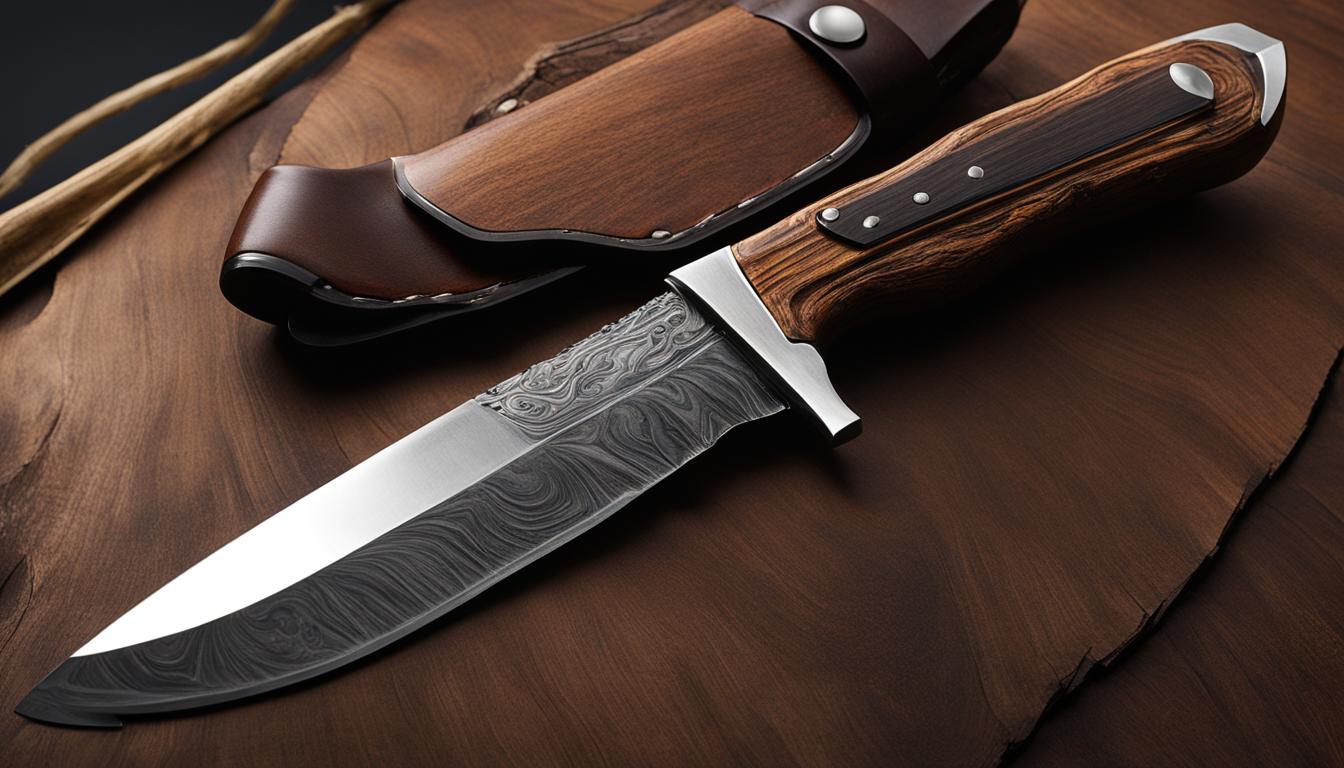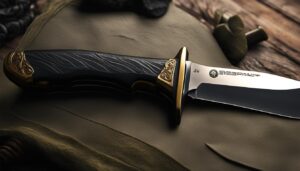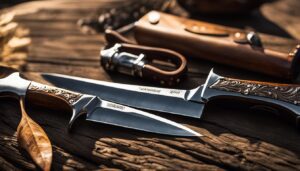Hunting knives with wooden handles have stood the test of time, captivating the hearts of collectors and enthusiasts with their classic beauty and lasting durability. Crafted with precision and functionality in mind, these knives offer a timeless appeal that enhances any hunting experience. In this article, I will guide you through the world of wooden-handled hunting knives, exploring the types of wood used for handles, the captivating grain patterns, the stability and maintenance considerations, and the comfort and customization options they provide.
Key Takeaways:
- Hunting knives with wooden handles combine beauty and functionality.
- Wood species like walnut, oak, and rosewood offer durability for everyday use.
- The grain patterns on wooden handles add visual interest and uniqueness.
- Proper finishing and maintenance enhance the stability and longevity of the handle.
- Wooden handles provide a comfortable grip and can be personalized.
Types of Wood for Knife Handles
When it comes to choosing a wooden handle for your hunting knife, there are numerous options available. Different wood species offer unique characteristics, grain patterns, and color variations, allowing you to select the perfect handle that meets your preferences and requirements.
Hardwoods such as walnut, oak, ebony, rosewood, and cocobolo are popular choices for knife handles due to their durability and ability to withstand everyday use. These woods are known for their strength and longevity, providing a solid grip that can handle rugged tasks. They also possess natural beauty, with their rich tones and distinct grain patterns, making each handle a work of art.
On the other hand, softwoods like pine, cedar, and spruce offer a lighter option for knives used primarily for decorative or occasional purposes. These woods are known for their versatility and ease of carving, allowing for intricate designs and detailing. While not as durable as hardwoods, they still provide a comfortable grip and add a touch of elegance to any knife.
Ultimately, the choice of wood for your knife handle comes down to personal preference and the specific needs of your hunting adventures. Whether you opt for the strength and sophistication of hardwood or the lightweight charm of softwood, a well-crafted wooden handle will enhance your hunting experience and ensure your knife stands the test of time.
| Wood Species | Characteristics |
|---|---|
| Walnut | Durable, rich color, elegant grain patterns |
| Oak | Strong, classic appearance, prominent grain |
| Ebony | Hard, dark black, fine-textured |
| Rosewood | Sturdy, reddish-brown, distinctive grain |
| Cocobolo | Very hard, reddish-brown, beautiful figure |
| Pine | Lightweight, pale color, easy to carve |
| Cedar | Soft, aromatic, attractive reddish-brown |
| Spruce | Light and strong, pale color, even texture |
Grain Patterns: Adding Visual Interest
The grain pattern of the wood is a defining feature of knife wood handles. It adds a unique visual interest and enhances the overall aesthetic appeal of the knife. There are various grain patterns found in wooden handles, each with its own distinct characteristics and charm.
Straight Grain Patterns: This grain pattern is characterized by linear fibers running parallel to each other. It offers a classic and clean look, providing a sense of elegance and simplicity.
Burl Grain Patterns: Burl patterns are known for their intricate swirls and knots. They create a mesmerizing and organic appearance, adding a touch of natural beauty to the knife handle.
Birdseye Grain Patterns: Birdseye patterns create small, circular markings on the wood. These unique markings resemble the eyes of a bird, hence the name. The intricate patterns add a sense of elegance and sophistication to the handle.
Curly Grain Patterns: Curly grain patterns feature wavy lines that create a sense of movement and depth. This pattern adds a touch of uniqueness and visual interest to the wood handle.
Spalted Grain Patterns: Spalted patterns are created by a natural fungal process, resulting in striking lines and dark streaks. This unique and unpredictable pattern adds a touch of boldness and character to the knife handle.
Each grain pattern offers a distinct visual appeal, allowing you to choose a knife handle that reflects your personal taste and style. Whether you prefer the classic and clean look of straight grain patterns or the intricate beauty of burl patterns, wooden handles with different grain patterns provide endless options for customization and individuality.
| Grain Pattern | Description |
|---|---|
| Straight Grain Patterns | Linear fibers running parallel to each other, offering a classic and clean look. |
| Burl Grain Patterns | Intricate swirls and knots, creating a mesmerizing and organic appearance. |
| Birdseye Grain Patterns | Small, circular markings resembling the eyes of a bird, adding elegance and sophistication. |
| Curly Grain Patterns | Wavy lines creating a sense of movement and depth, adding uniqueness and visual interest. |
| Spalted Grain Patterns | Striking lines and dark streaks resulting from a natural fungal process, adding boldness and character. |
Stability, Finishing, and Maintenance
When it comes to the stability of wooden knife handles, choosing the right wood species is crucial. Certain woods are more prone to warping or expanding with changes in temperature and humidity, which can compromise the handle’s fit and integrity over time. Proper drying techniques and treatments can enhance the stability of the wood, ensuring that your hunting knife remains reliable and durable throughout its lifespan.
Finishing wood handles not only enhances their appearance but also provides protection against moisture. Applying oils, waxes, or varnishes creates a barrier that helps prevent the wood from absorbing excess moisture, which could lead to swelling or cracking. It’s important to note, however, that excessive exposure to moisture should still be avoided to maintain the integrity of the handle.
Maintaining wooden handles is relatively simple and requires regular care. Applying oil or wax to the handle helps prevent drying or cracking, preserving the natural beauty and durability of the wood. Additionally, keeping the handle clean and dry after each use is essential. Avoid exposing the handle to prolonged moisture or harsh cleaning agents that could damage the wood. By following these maintenance practices, you can ensure that your wooden-handled hunting knife continues to provide a comfortable and reliable grip for years to come.
| Wood Species | Stability | Finishing | Maintenance |
|---|---|---|---|
| Walnut | High stability | Enhances natural color and grain | Regular oiling or waxing |
| Oak | Moderate stability | Durable finish, enhances natural grain | Regular oiling or waxing |
| Ebony | High stability | Enhances natural color, provides a smooth finish | Regular oiling or waxing |
| Rosewood | Moderate stability | Brings out rich colors and grain patterns | Regular oiling or waxing |
| Cocobolo | High stability | Enhances natural reddish-brown hues | Regular oiling or waxing |
Conclusion
Hunting knives with wooden handles have a timeless appeal that combines beauty and functionality. These wood handle hunting knives offer a wide range of options, from different wood types to captivating grain patterns, ensuring there’s a knife to suit every taste. Whether you’re looking for hunting knives with wood grip for your outdoor adventures or wooden handle game knives for display, these knives are a perfect choice.
Crafted with expert artistry and craftsmanship, wooden handles provide a natural feel and a comfortable grip. The durability of these handles ensures that your hunting knife will withstand the test of time, whether you’re using it in the kitchen or out in the great outdoors.
Wooden handle hunting blades are not only functional but also customizable. You can personalize your knife with engravings or other decorative touches to make it truly unique. The finishing and maintenance processes, such as applying oils or waxes, not only protect the wood but also enhance its appearance, preserving its natural beauty for years to come.
So, if you’re in search of hunting knives with wooden handles, look no further. These knives offer the perfect blend of tradition, durability, and visual appeal. Whether you’re a collector, an enthusiast, or a professional hunter, wood handle hunting knives are an excellent choice.
FAQ
What types of wood are commonly used for knife handles?
Hardwoods like walnut, oak, ebony, rosewood, and cocobolo are commonly used for knife handles. Softwoods like pine, cedar, and spruce are also used for decorative or occasional use knives.
What are the different grain patterns found in wooden knife handles?
There are various grain patterns found in wooden knife handles. Straight grain patterns offer a classic and clean aesthetic. Burl patterns showcase intricate swirls and knots. Birdseye grain patterns create small, circular markings. Curly grain patterns add a sense of movement with wavy lines. Spalted patterns feature striking lines and dark streaks.
How important is the stability of the wood for knife handles?
The stability of the wood is crucial for knife handles to ensure longevity. Wood that warps or expands excessively with changes in temperature or humidity can compromise the handle’s fit and integrity.
How should wooden knife handles be finished and maintained?
Wooden knife handles can be finished using oils, waxes, or varnishes to enhance their appearance and protect them from moisture. Regular maintenance, such as applying oil or wax, helps prevent drying or cracking and preserves the natural beauty and durability of the handle.
What are the benefits of hunting knives with wooden handles?
Hunting knives with wooden handles offer a blend of beauty and functionality. They provide a natural feel, comfortable grip, and durability. The wide range of wood types, captivating grain patterns, stability, finishing options, and opportunities for personalization make them exquisite pieces of functional art.
Source Links
- https://www.kaltimber.com/blog/the-allure-of-knife-wood-handles-a-perfect-blend-of-beauty-and-functionality
- https://malikaknives.store/product/damascus-guthook-hunting-knife-razor-sharp-blade-0344/
- https://malikaknives.store/product/j2-guthook-hunting-knife-exquisite-craftsmanship-razor-sharp-blade-0337/





